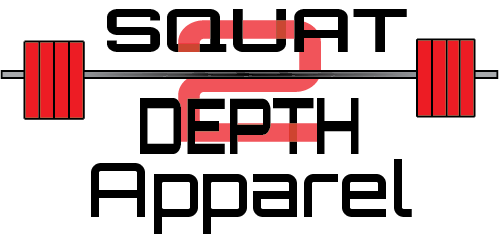
Squat Variations For Depth Assistance
By Steve DeNovi (PRs Performance)
As the new Squat 2 Depth shirt says…...

….and I am happy to provide the help needed to prevent this horrible atrocity.
In seriousness though, with Squat 2 Depth being a company that markets and appeals to the powerlifting community, most of you probably aren’t quarter squatting, its your friends and fellow gym members who are breaking this squat law. But you very well may be cutting your squats a tad high and wanting to learn what needs to be done to consistently hit competition depth in training, and that is where this article comes in. This could very well be an article on form and technique, as that is the most important aspect in hitting depth, but it is also highly individual. So instead of trying to break down the biomechanics for each and every scenario, I want to take the approach of the general variations I would have someone perform if they are having trouble squatting to full competition depth. And these variations mainly come down to helping put the lifter into the position they need to achieve the proper depth. So without further ado, these are the four main variations I would choose between when looking at someone’s mechanics and trying to help them create the habit of hitting competition depth in their daily training.
Pause Squats
Want to see what “depth” feels like? What better way than spending some extra time in that position! Pause squats are usually my go to, as it allows extended time at depth to start learning what that position feels like and the range of motion it takes to get there. But even more so than that, it forces the lifter to improve their bracing mechanics in the bottom position.
Why do people cut depth? Because they are weaker in that position, simple as that. And while that 1-2 extra inches does increase difficulty due to the increased flexion, I think the lack of strength comes less from that and more from the improper bracing. I have seen time after time lifters becoming just as strong squatting that extra 1-2 inches, it was just a matter of learning how to feel stable when squatting that low. Pause squats is the answer for this, and kills two birds with one stone in regards to feeling the position needed and also improving the bracing within that position.
Tempo Squats
Nothing works better on improving form than slowing the movement down. If you are a race car driver and want to learn the proper lines on a new track, you aren’t going to go full speed the first lap. You are going to slow it down to learn the intricacies of each turn. The same goes for the squat. Tempo squats with a 3-4 second eccentric allow you the time to actively cue during the descent, something that isn’t quite possible to do effectively during a normal competition squat. And many times, tempo squats are best utilized within other variations as well. It could be a tempo pause squat, where you use the pause to feel the bottom position and improve bracing, but utilize the tempo during the eccentric to find the proper movement pattern during the descent to get you to the correct bottom position.
High Pause Squats
Even though I mentioned I wasn’t going to talk about biomechanics, there is one very common issue with squat form that plagues lifters from hitting depth, and that is too much knee flexion and not enough at the hips. And my fix for this is high pause squats. The initial break on a squat should look like you are guarding someone in basketball. Hips and knees break together, and from there you drop into your squat pattern. So what the high pause squat does is it forces you to break properly from the start. The vast majority of people who are too knee dominant to hit depth end up in that position due to a bad initial break. So using the high pause squat, you break at the knees and hips simultaneously, pause just a couple inches down from your initial starting position and then drop into your squat. It’s amazing how many people magically can hit depth when utilizing this variation.
Box Touch Squats
Last, and probably least, is box touch squats. These would be a last resort, but if someone just continues to struggle hitting depth, I’ll have them place a box to very lightly touch during each rep of the competition squat. Different than a box squat, here I don’t want the lifter to actually sit on the box at all. Only thing it is being used for is a neural cue on when they have hit depth. So make sure to pick a box that is the right height for you to fully reach depth before just lightly touching.
There you go! Four squat variations to help you improve your consistency in training with hitting competition depth. And for those saying, “I’ll hit depth once its game day, don’t worry”, and they continue to train high in training, all I have to say is good luck. If you don’t hit depth in training, you don’t pause your bench, and you touch and go all your deadlifts, you are going to have a rude awakening competition day when you can’t hit the numbers you were shooting for. Practice for competition, not for Instagram likes, and I guarantee your meet day will be a much more enjoyable experience. If you have any questions regarding any of the information in this article, feel free to shoot me a message on Instagram at @prs_performance or send me an email at sdenovi@gmail.com and I’d be happy to help!
